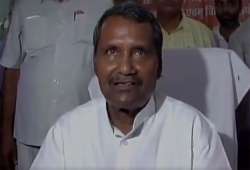‘What is full form of GST?’ When Yogi's minister, tasked with explaining benefits, struggled with the basics
Ramapati Shastri, a minister in Yogi Aditynath's cabinet, failed to state the full form of GST.

When 1.3 crore people of India wake up tomorrow, a lot would have changed in the country as a new tax regime, the Goods and Services Tax, would be in effect. In the country where over 25 per cent of adult population is still illiterate, it is understandable that many would not know the full form of the GST or what is GST. But for a minister, who has been tasked with explaining the GST benefits to the people, not knowing the meaning of GST is plain embarrassing.
The minister in question here is Uttar Pradesh cabinet minister Ramapati Shastri. On Thursday, the minister who is among those responsible for spreading the good word on GST, even failed to state the GST full form, let alone explain the meaning of GST or what the GST means for the Indian economy.
Uttar Pradesh Chief Minister Yogi Adityanath had asked his ministers on June 14 to explain the benefits of GST to people who were feeling confused ahead of the new tax regime. He had also asked his ministers and senior officials to conduct symposia to make people aware of GST. A workshop was held by the Chief Minister for his cabinet colleagues to explain the meaning and nitty-gritties of GST. However, it seems the ministers learnt little from the workshop.
As part of the exercise to explain to the traders the meaning of GST and the benefits it would bring, the Social Welfare, Scheduled Castes and Tribal Affairs minister was interacting with local businessmen in Maharajganj on Thursday. He was caught on the wrong foot when mediapersons asked him for the GST full form.
"The full form of GST is...," fumbled Shastri in response. Though someone from the background tried to prompt the minister, he failed to make use of the clue.
However, realising that he had committed a goof-up, he hastened to added that he knew the GST full form but was not able to recollect it instantly.
"I know the full form. I am going through all the relevant documents to gather more knowledge about the GST," Shastri said.
He is the minister in-charge of Maharajganj district.
The State GST Bill was tabled in a specially convened session of the Uttar Pradesh Assembly on May 15 and after its passage, a workshop was held to apprise all legislators of the salient features of the proposed legislation on GST.
State minister Suresh Kumar Khanna said, "After the new tax regime is implemented, revenue of the state is likely to increase."
Uttar Pradesh, as a consumer state, is projected to be a net tax gainer under the new tax regime as the GST is a destination-based taxation system as against manufacturing source based.
The state has also witnessed its tax kitty burgeon under the Value Added Tax (VAT) regime. VAT was implemented in the state on January 1, 2008, during the Mayawati government.
Seen as a path-breaking step in the taxation regime, GST is expected to create a congenial and cohesive atmosphere for business in the country.